We are getting into our groove now, going with the flow and embracing the possibilities, this newsletter went together really well and it even also has all the codes of the pictured cards.
At the moment I am writing a mini biography of Aylmer Maurice Rundle, for a particular purpose which will be revealed asap. Many of you will not know him or know of him but he was an early editor of our magazine when it was called "The Cartophilic World". It will eventually also appear on our site, as well as where it is intended to go.
After that I hope to crack on with the index to these newsletters, which will let me feature more new cards, not just the same old same old.
Watch this space for all the news on those - but first we have things to do this week....
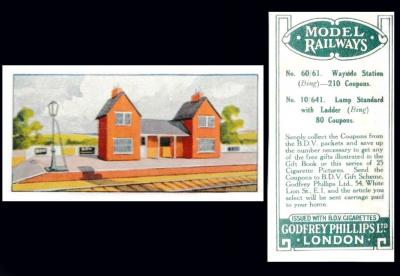
P521-342 : P50-68 : RB.113-101 : RB.13/101 [tobacco : UK] Godfrey Phillips "Model Railways" (1927) Un/25
Hands up if you own a paperback book? Well today is their day so #PaperbackBookDay and let us see your current favourite, or what you are reading right now
True, they may not be as long lasting as a hardback, but they are cheap and best of all they bring books within the reach of everyone.
You may be wondering why we have a railway station here, but it was the railway that popularised the paperback, at least in America, where thin paper "dime store novels" brought portable reading to the masses before many of them were ready for it. These thin but important volumes began in the early 1860s, and the Transcontinental Railroad opened in 1869, allowing passengers to travel by train to California, Iowa, or Nebraska in four days. And the best way to pass four days, when the scenery starts to bore you, is with a book, but not something that is awkward to transport, or too heavy for luggage; not when you can take something small enough to fold into a pocket.
Now here is the really odd fact, for we were ahead of the game as far as railway station bookstalls, with William Henry Smith`s first railway bookstall appearing in November 1848 at Victoria Station in Manchester - however it did not sell paperbacks for almost a century. That is because the first one in this country was published by Penguin, today in 1935, (it was Ariel by Andre Maurois, a semi-fictionalized story of the life of the poet Percy Bysshe Shelley).
As for our station, this is a really intriguing cigarette card, because it is not just any old railway model but it actually existed; the whole set shows actual tinplate O Gauge model railway artefacts that could be exchanged with coupons, some are by British maker Bassett Lowke, and others, like ours was by Gebruder Bing in Germany, one of the most popular and prolific makers, and even better it appears in their 1928 catalogue on page ten as 60/61, which is the very same number as on the card. Sadly the catalogue is in black and white, but you can still see its a pretty good representation, except for the fact that Phillips seem to have made an error with the caption, and called it a "wayside station" rather than the correct "country station". And if you steam off to Brighton Toy Museum online you`ll find lots of links to sites about Bing!
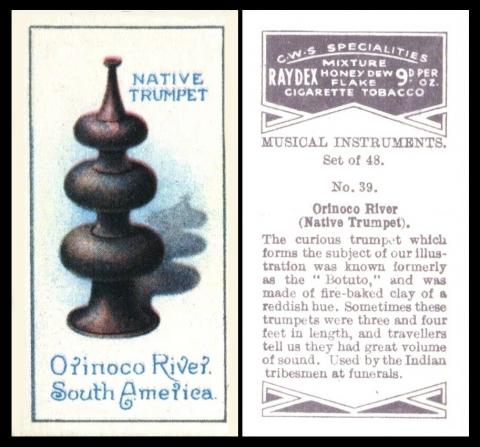
C792-550 : C130-27 [tobacco : UK] Co-Operative Wholesale Society / C.W.S. "Musical Instruments" (1934) 39/48
Today its #UncommonInstrumentDay - or #UncommonInstrumentAwarenessDay, so lets have a look at a really uncommon set by the Co-operative Wholesale Company, which was issued with Raydex Mixture, and Honeydew Flake.
There are loads of unusual instruments in this set, and I debated whether to go for the Sistrum (card 34), from Egypot and Abyssinia, which was shaken much like a tambourine but on an upright stick with a fun little sculpted human head at the bottom rather than around the edges of a round disc - then there was the Chinese Cheng or mouth organ (card 36) which is like a proper church organ, lots of bamboo pipes banded together, but in miniature size. However in the end I decided on the Orinoco River Trumpet, "made of fire baked clay of a reddish hue", which is not so far removed from those ancient Incan and Mayan pots and ceremonial figures.
It appears this illustration, and some of the text, comes from Carl Engel`s Musical Instruments, which was published in 1875. Joseph Gumilla, quoted in the text, was a Jesuit Priest who travelled the Orinoco, about a hundred and fifty years before the publication of Engel`s work, and created one of the most important works on its flora and fauna.
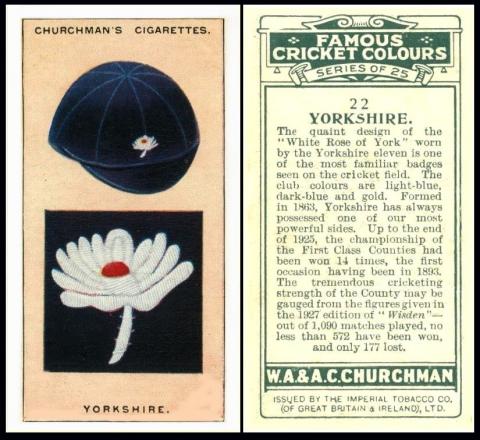
C504-480 : C82-46 : RB.10-49 [tobacco : UK] W.A. & A.C. Churchman "Famous Cricket Colours" (May 1928) 22/25
For #YorkshireDay we are going to have a bit of cricket.
This card tells us that the County "has always possessed one of our most powerful sides".
In fact the Yorkshire County Cricket Club still rates as one of the most successful worldwide, though it is not the earliest team, that honour goes to Sheffield Cricket Club, founded in the early 1750s - Yorkshire County only being founded in 1863.
The badge on this card was actually designed by Lord Hawke, club captain, who played for Yorkshire and England from 1881 to 1911 (not continuously of course) although he was actually born in Lincolnshire. He took the idea of his club badge from one that was being used already byLancashire, a red rose, however, he used rather a bit of artistic licence and gave it eleven petals, one of which represented each member of the team, and only they could wear the badge.
If any of our Yorkshire members is on twitter or instagram why not upload your favourite card today, using #YorkshireCartophily
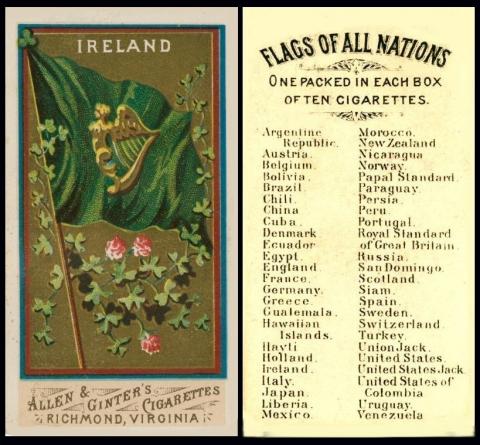
A400-090 : RB.118-138 : USA/9 [tobacco : OS ; USA] Allen & Ginter "Flags of All Nations" (forgot to look!) Un/50
Here is a puzzle for you on Find a Four Leaf Clover Day - #FindAFourLeafCloveDay
Mind you if you look long enough your eyes will blur to the point that they all look like four leaf clovers.
The plants here are actually shamrock, not clovers, the difference being that a shamrock is a traditional three leafed clover and never has a fourth leaf, whilst a clover can sometimes throw up a genetic mutation that gives it four leaves. However in many places a shamrock is shown as a four leaf clover, just to confuse things!
And also the word shamrock actually means `little clover`, though it depends on who you are asking as to whether `little` means `young` or `small`
This card was issued in various versions, and there are ten cards which can be found with both a plain colour or a fancy background, these are Austria, Belgium, France, Holland, Italy, Japan. You can also find the Royal Standard of Great Britain with a yellow or golden sun. And then there is a card of the Papal States which was also issued as the Pontifical States; not sure which printing is rarer, but will find out. Some of the printings also only have 48 cards, the two scarce ones being Korea and Roumania - Jefferson Burdick valued Korea at 50 cents but Roumania at $5. However this is only in certain printings, not all.

C151-245 : C18-42 : Ha534 [tobacco : UK] Carreras "Famous Film Stars" (April 1935) 27/96
Today in 1905 a small baby was born in Durango, Mexico. There seems some debate about her actual name as most modern sources quote `María de los Dolores Asúnsolo y López Negrete`. However our card adds `Lolita` in front and also changes the ending to de Martinez`, which was actually through marriage, in 1921 to Jaime Martinez Del Río a wealthy Mexican. This would also therefore explain how as Dolores Del Rio she would make her first motion picture "Joanna" (1925). However despite sucess in "Ramona" (1928) it was talking pictures that made her one of the first Mexican actresses to become an international star, most notably "Flying Down to Rio" in 1933. Sadly she had divorced her husband in 1926 though she kept his name, and she would eventually marry one of M.G.M.s art and production directors, Cedric Gibbons.
In 1942 she returned to Mexico, had a brief but exciting affair with Orson Welles, and left Cedric Gibbons. She never had children of her own, but she did lots of work with orphans and orphanages.
The Trading Card Database has her first British card as being from the first series of Bridgewater miniature photographic "Film Stars" (1932) and despite the fact that she was silent star before she moved to talkies this may well be true, unless you know otherwise.
A really interesting article about her life appears in Vanity Fair, but they are one of my favourite magazines anyway! And she has twitter sites, including @DoloresDelRio1
One of the most interesting things about this set is that six cards were reissued with other fronts, namely :

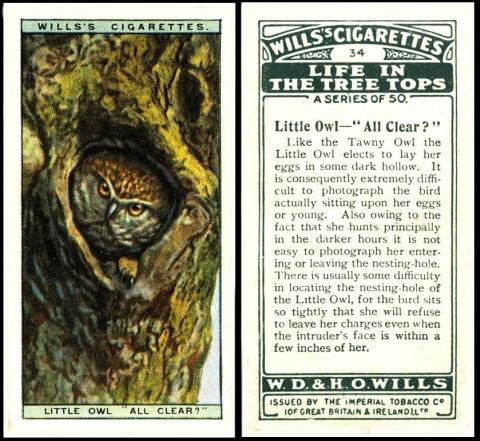
W675-194 : W62-155 : W/254A [tobacco : UK] W.D. & H.O. Wills "Life in the Treetops" (october 1925) 34/50
Today its #InternationalOwlAwarenessDay.
I like the stately look of the owl, but I do not approve of their idea of dinner, for I am rather fond of rodents, and so frequently owls on cards are shown with some unfortunate hanging limply from their beak which makes me sad. and even if the thought is not reinforced on the front it is mentioned on the back.
However at last I found an owl with no mention of dinner, so I can think they have converted to veganism and include it with a clear conscience.
The strange thing about this card is that they might have got their facts wrong, as this little owl is actually one of the few that hunt during the daytime - as opposed to most owls, which are nocturnal and only hunt in the darkness once night falls.
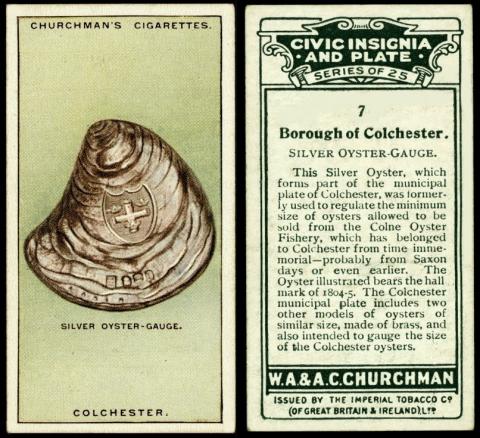
C504-445 : C82-39 : RB.10-33 [tobacco : UK] W.A. & A.C. Churchman "Civic Insignia and Plate" (May 1926) 7/25
We are going off on a tangent here for #NationalOysterDay as here we have a silver oyster gauge which was made in 1804-5/ - however these devices can be found made of other materials, and are known to date as far back as the sixteenth century.
And they do not only exist in Colchester, they are used worldwide to tell whether the oyster is of a legal size to catch, those that are of a certain size are fine but those that are too small have to be returned to the sea again.
Colchester is famous for oysters, and much local celebration occurs on the first Friday of September when the oyster fishery opens for business (except for by the oysters, of course). The closing of the season is marked by a huge oyster feast, on the last Friday of October, which has been held every year since the fourteenth century
This week's Cards of the Day...
were all about Lumberjack Day, always celebrated on the Friday of the last full week in July. Not sure why yet! You might think that cutting down trees goes against my grain, but it is necessary for ecology, sometimes they are damaged by natural events like the weather, and sometimes they are growing in the wrong place.
At one time a male worker was called a Lumberjack and a female was a Lumberjill; in fact during the Second World War, the ladies of the Women's Timber Corps, just one of the branches of the Land Army, were often referred to as that, and it does seem to have continued.
Irrespective of gender their job description is to cut down trees and make the best use of the material that they can recover. Often a fallen tree is empty, destroyed by the chewing of tiny creatures or by parasitic damage, but there is still a use for sections of external woods for furniture and sculpture.
Saturday, 23rd July 2022
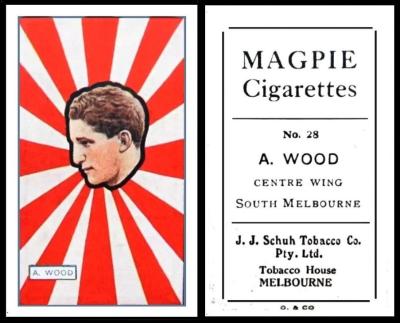
Here we have an Australian Footballer, simply described as "A. Wood - Centre Wing - South Melbourne".
A little research fleshes this out, and discovers that his full name was Arthur Charles Wood, and that he was born on the 24th of June 1898. He was only five foot four inches tall, but nippy, and hard to tackle.
He started with South Melbourne in 1917, and later coached them too, though at the time he was only in his mid twenties. About the time that our card was issued he was also captain-coach of Maryborough, which joined the Ballarat Football League in 1924 and surprised everyone by winning not only that year but the next year too.
He died, aged 60, in 1959.
This is one of my favourite sets, simply for its amazing colour. Hard to believe that it is a hundred years old this year, and still as fresh as ever.
It first appears in our original "Australasian Miscellaneous Booklet" (RB.20, issued in 1951) as part of a much larger grouping of four sets all known as Australian Footballers though none are titled. You can read the full listing of those sets, and see the illustrations and checklists, with the card from set 1.A which was our Card of the Day for the 12th of October 2024. However the entry for just this set reads :
48.1. Australian Footballers (adopted title). Three series are known, two of which deal exclusively with players in the Victorian League, and one with players from this League and from the South Australian League.
Series B. Size 66 x 40 m/m. Fronts per Fig.48-B in colour, head and neck studies in rays of Club Colours, captions at left base. Backs in black, with name of player and position in team. Issued about 1923. Numbered set of 40, Victorian League players.
As this set was numbered, it does not have a checklist.
Sunday, 24th July 2022
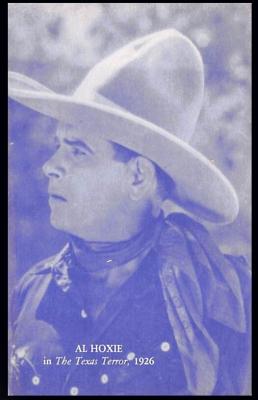
This is just one of the many cards which were available for one cent each at amusement arcades in the United States of America during the early days of the silent movies. Because it was unseemly for ladies to enter such places, you will find they mainly feature cowboy or action stars, in either head and shoulders portraits like ours, or thrilling stills from the movie.
There were two main producers of these cards. This card was by Mutoscope, who seem to specialise in this blue colour, though later on also produced full colour pin-up cards, some of which are featured in the current edition of our members only magazine. Then there was the Exhibit Supply Co. of Chicago, who also did many cards in black and white, and went on for many years, even to pop star cards in the 1950s.
We chose this card because most lumberjacks are based in Canada and America, the home of the motion picture. However there is also a very cryptic clue as a 1918 lumberjack film called 'Blue Blazes' Rawden, which William S. Hart directed and starred in, and in the cast you will find Al Hoxie's brother, Jack.
Monday, 25th July 2022
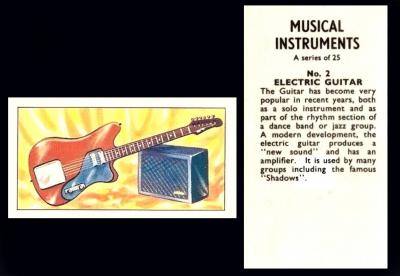
A very attractive set but sadly anonymous. And there is definitely space for an issuer`s name. I'm wondering if anyone out there knows of an issuer who produced cards in a similar typeface or style so that we might get closer to the truth?
The date might be reached by working out the timeline of the invention of the electric guitar (I prefer the acoustic myself) and look, it mentions "The Shadows"... they were formed in 1958, but were then called "The Drifters".
By the way there is only one code because I can't find it in the original four volume set of trade indexes, but do let me know if you can.
Anyway the clue here referred to the fact that an electric guitar is often called an "Axe". It seems there is no real answer as to why, but according to the guys at Guitarist Next Door apparently a saxophone was also once known as an Axe.
Tuesday, 26th July 2022
![G075-170 : G12-21 [tobacco : UK] Gallaher "How to Do It" (1916) 69/100](/sites/default/files/styles/content_aligned/public/2022-07/gallaher%20how%20to%20do%20it%20%20%282%29_0.jpg?itok=fU4MWfFb)
Here we have a spot of home repair. I doubt that a lumberjack would have mended his axe with wire and still been able to fell the mighty forest, but he could have still used it for trimming smaller branches.
At home, and in our gardens, it ought to be easy to make repairs and continue to use things, as it used to be in the time of this card, and it was common practise to do so, hence the series of Household Hints and Garden Hints.
The problem was the arrival of electronic gadgets, which are sometimes unable to be mended, and have no other use if they are broken. There may not seem to be a solution to this, because they are definitely easy to use, lighter, and quicker. However, there is a way around this, and that is to hire the larger equipment from one of the hire clubs which are springing up all over. There is almost certainly one near you. In London there is a scheme called The Library of Things and it now has ten locations; you simply get the urge to make pasta and hire a pasta machine, then return it afterwards. Think of the things in your home that you maybe look at once a week and think of the space they will make if you had only hired them - and investigate when something breaks.
By the way most Currys stores will accept small broken electrical items and make sure they are reused even if only as parts for training, the other parts are also disposed of ethically, and there is no charge if you can take them to the store and give them in at the counter.
And if you live outside London, have a look at fat llama which is an online network of things to hire.
Wednesday, 27th July 2022
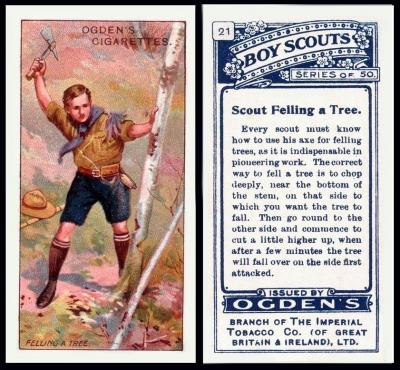
The main thing that I notice here is that hat, on the tree, which is rather sourly called a "lemon squeezer", and which it does resemble, if you think of the idea of pushing a lemon on to the top of the hat and squeezing it.
It was actually introduced by Baden Powell himself in the early 1900s and it had much affection awarded it from the Scouts, but it was not very practical, no use in wet weather, and most of all it cost quite a lot to make, all the bending and shaping, which made it one of the most expensive items for the boys to afford. It was replaced with a beret, but after a very brief flirtation both the beret and any idea of having an official scout hat for the boys was abandoned - though they were still issued to scout masters,
If you look closely at your military cards you will also see these "lemon squeezer" hats on military cards, for they were also used by the Army, especially New Zealand, which was actually the first force to use them, during the Gallipoli Campaign. It is often said they invented them too. They were later also used by American and Canadian forces.
But I still don`t know why the two uniforms on the cards we had on display this week were of a different colour?
As for our card, there is rather a tale to tell - so let us start with a chart which will contain all the links to where the sets, by all the makers, appear, namely :
First fifty pictures
- Imperial Tob. of Canada "Boy Scouts"
- Churchman "Boy Scouts" - 3rd Series - 1-50 - blue back
- Churchman "Boy Scouts" - 3rd Series - 1-50 - brown back
- Ogden "Boy Scouts" - A Series - 1-50 blue back - https://csgb.co.uk/cardoftheday/2022-07-27
- Ogden "Boy Scouts" - A Series - 1-50 green back
Second fifty pictures
- Churchman "Boy Scouts" - 2nd Series - 1-50 - brown back
- Ogden "Boy Scouts" - A Series - 51-100 blue back - https://csgb.co.uk/publications/newsletter/2023-03-25 [in newsletter, scroll down to Monday 27 March 2023]
- Ogden "Boy Scouts" - A Series - 51-100 green back
- John Player "Boy Scouts" - grey back
Third fifty pictures
- Churchman "Boy Scouts" - 1st Series - 1-50 brown back
- Ogden "Boy Scouts" - 3rd Series - 101-150 blue back - https://csgb.co.uk/cardoftheday/2022-04-24
- Ogden "Boy Scouts" - 3rd Series - 101-150 green back
Fourth fifty pictures
- Ogden "Boy Scouts" - 4rd Series - 151-200 green back - https://csgb.co.uk/cardoftheday/2022-04-24
Fifth fifty pictures
- Ogden "Boy Scouts" - 5th Series - 201-225 green back - https://csgb.co.uk/cardoftheday/2022-03-04
Different pictures
- Ogden "Boy Scouts" - 1929 -
As for the grouping of just the Ogden`s issues, the following is extracted from our original reference book to the cards of that company, issued in 1949 as RB.15. That reads :
225 BOY SCOUTS (1911-14). Fronts lithographed in colour. Backs with descriptive text. Home issues.
41. Series of 50. Numbered 1-50. Backs in (a) blue (b) green. Issued 1911. Varieties : Nos.39 and 40 are found with text transposed. Similar series issued by Churchman (3rd Series) and B.A.T.
42. 2nd Series of 50. Numbered 51-100. Backs in (a) blue (b) green. Issued 1912. Similar series issued by Churchman (2nd Series) and Player
43. 3rd Series of 50. Numbered 101-150. Backs in (a) blue (b) green. Issued 1912. Similar series issued by Churchman (1st Series).
44. 4th Series of 50. Numbered 151-200, Backs in green. Issued 1913
45. 5th Series. 25 subjects. Numbered 201-225. Backs in green. Issued 1914.
I next pick the set up in my 1950 London Cigarette Card Company part one catalogue and handbook issued in 1950, which covers cards issued between 1888 and 1919. They give each set a reference number, which is the number at the front of each listing below, and they also tell us that the sets were size "A" (approximately 36 x 68 m/m) and printing "C" (which means in colour), as well as, most interestingly, the current price of odds and complete sets at the date of printing. The full entry, as far as the catalogue, reads :
20. A. C. 50. Boy Scouts (Jan. 1911) :- H.62
A. Blue back ..... [odds] 1/6 to 3/- [sets] £ 7
B. Green back .. [odds] 3/- to 7/6 [no sets available]21. A. C. 50. Boy Scouts, 2nd Series (Feb. 1912) :- H.62
A. Blue back ..... [odds] 1/3 to 3/- [sets] £ 8
B. Green back .. [odds] 3/- to 7/6 [no sets available]22. A. C. 50. Boy Scouts, 3rd Series (Oct. 1912) :- H.62
A. Blue back ..... [odds] 1/6 to 4/- [sets] £ 10
B. Green back .. [odds] 3/- to 7/6 [sets] £ 2023. A. C. 50. Boy Scouts, 4th Series, green back, (Nov. 1913)
[odds] 1/9 to 5/- [sets] £ 1223. A. C. 25. Boy Scouts, 5th Series, green back, (Sep. 1914)
[odds] 2/6 to 5/- [sets] £ 7
To see the pricings for the Churchman sets, nip along to our Card of the Day for the 23rd of September, 2025 - though this may move when I feature a Churchman series one card.
The Handbook, which is the H.62 code, simply adds in the other issuers of these sets, and that reads :
H.62. BOY SCOUTS. (titled series). Fronts in colour. Three numbered series of 50 cards each.
1st 50 subjects.
Pre 1919 Churchman - 3rd Series
A. Brown back
B. Blue back
Ogden - 1st Series
A. Blue back
B. Green back
Overseas Anonymous - Blue back. Recorded in Burdick under C.47, page 41, as issued by Imperial Tobacco Co. of Canada.2nd 50 subjects.
Pre 1919 Churchman - 2nd Series, brown back
Ogden - 2nd Series
A. Blue back
B. Green back
Overseas Player - Grey back.3rd 50 subjects.
Pre 1919 Churchman - 1st Series, brown back
Ogden - 3rd Series
A. Blue back
B. Green backOgden also issued a 4th and 5th Series.
Now back to our listing of all the cards in this group, and on to our World Tobacco Issues Index, we will find them amongst Section 4.A, with sets issued between 1903 and 1917. The wording is much reduced though, to :
BOY SCOUTS. Sm. Nd. See H.62. ... O/2-94
1. "Series of 50". Nd. 1/50. Back in (A) blue (B) green
2. "2nd Series of 50". Nd. 51/100. Back in (A) blue (B) green
3. "3rd Series of 50". Nd. 101/150. Back in (A) blue (B) green
4. "4th Series of 50". Nd. 151/200. Back in green
5. "5th Series". Nd. 201/225. Back in green
That other series does not follow, for it was issued later; instead, it appears in Section 4.B, for sets issued between 1922 and 1939, and the entry reads :
BOY SCOUTS. Sm. Nd. (50). See RB.21/215-46.A ... O/2-130
RB.21 was the original British American Tobacco Company Booklet. This was issued in 1952, and was the last of the small booklets before the World Tobacco Issues Index combined everything together. It does not actually say much in the listing, which reads ; "215-46. BOY SCOUTS (1929). This series was issued as follows :- A. Ogden`s Home issue. B. Anonymous issue, with letterpress on back". However, if we go to the index at the front of the book we learn that this second, Anonymous version, was issued through British American Tobacco in 1930, in Malaya and the Channel Islands.
Looking at our first series set, and especially the final wording : "Similar series issued by Churchman (3rd Series) and B.A.T.", the B.A.T. version of the set had a blue back, but no mention of a manufacturer, however we know that it was actually issued in 1911 It originally had an album clause up the sides, but this was later blocked out in blue. There is also a very curious fact, that being that some of these cards have been found with a non-official label stuck on which reads “Help the Boy Scout Fund .. Grand Entertainment 2nd May`14”. This originated in South Africa. No idea if this appears on a whole set or whether it was just isolated cards used to serve a purpose. But I am sure one of our readers can help.
The Ogden “3rd Series of 50” was issued in October 1912,
The Churchman “1st Series” was issued in January 1916, and newly numbered 1-50, because these cards had formed Ogden`s third series of 1912.
Churchman`s “3rd Series” appeared in October 1916, and these were the cards which had appeared as Ogden`s first series of 1911, re-numbered to 101-150. (now you know why I extracted this lot) The entire set was printed in two different back versions, brown and blue. Curiously, just like the Ogden set, you find the error cards at 39 and 40.
Ogden`s “4th Series of 50”, issued in November 1913, “5th Series”, September 1914,
The listing actually continues with another, but later, and unconnected set, namely :
46. 50 BOY SCOUTS. (1929). Fronts printed by letterpress in colour. Backs in grey, with descriptive text. Home issue, 1929. Similar series issued by B.A.T.
Thursday, 28th July 2022
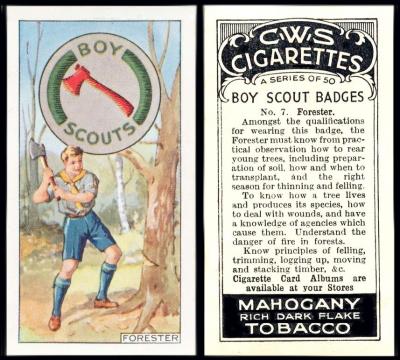
Our second forester and it shows the badge which was awarded in the late 1930s.
In fact this badge still remains, though it no longer shows an axe, and it is now called the Forester Activity badge. I could say that it also has a more ecological theme, but I am delighted to say that if you read the text on this card you will see that even then there was an emphasis on not just cutting them down, but the recipient of the badge needed to know how to rear young trees, prepare the soil, transplanting, ways to treat diseases and damage, and also understanding the danger of fires in forests, which you may think is a more recent phenomenon.
The list of skills you must study in order to be awarded this badge today shows the key notes of preparing soil and successfully transplanting and growing a sapling still remain., However it now involves forestry management skills, and includes the awareness of early signs of ecological and weather damage. There is one definite change, for it has a more regional theme, including the knowledge of local conditions and soil types, and also you have to be able to identify at least eight trees from your own location.
And tellingly, the only time that tools are mentioned is regarding the knowledge of safe ways to use and store them.
This set is listed in our World Tobacco Issues Index as simply :
BOY SCOUT SERIES. Sm. Nd. (25)
Friday, 29th July 2022
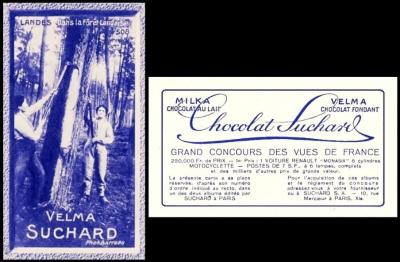
This card is very odd, because it shows a forest, and if you look closely the nearest man to the front is scraping away the bark of the tree. That begs a bit of a question, for it could mean they are forestry workers doing a bit of remedial work to help the tree by removing certain unwanted insects which have burrowed beneath the bark and are destroying the tree; a very skilful job, for if you remove too much bark, or in the wrong place, or completely cut a band around the trunk, known as a ring band, then the tree will probably die, because the bark is a vital component thereof, and amongst many things, it transports the water and nutrients around the tree`s internal systems, and it cannot do that without a continuous passage up and around the tree.
On the other hand, there is an alternative to what may be going on here, and that is a curious practice called bark stripping. It is illegal, and harmful to the tree, but the belief in many countries is that bark can be used as medicine. This is frowned upon by scientific studies who say that it is no use for that, and especially not when stripped from the base of the tree, which is harder and less likely to contain useful substances - though in saying this they have inadvertently suggested that higher up there are such things. Now if you look again at the card, you will see that the stripping is mainly being carried out at arms length above the head, though a long strip has been cut, maybe as a test.
The location is given as "Dans la Foret Landaise" - or in the forest of Landaise. This area is huge, going into two separate areas of France, and within it are the sources of several rivers. The trees there are maritime pine, and they were actually grown specifically to combat erosion, as well as to allow the roots to cleanse the rather dense and patchy soil.
However there is something rather special about maritime pine, and that is that the bark is indeed used for medicine, both legally, and secretly. Its main uses are in relieving asthma, and also for improving the immune system and the circulation of blood through the human body. It can also be used to prevent infections, and, only fairly recently, is being studied as a possible relief for ADHD sufferers.
I thought I would struggle to identify this but I took a chance and put Suchard in the search facility of The Trading Card Database/Suchard/P2 and found it actually has this set, along with many other variants, those being listed at Suchard/Sets.
This is quite a hard issue to sort out, for there are several sets that look alike. The earliest one, issued in 1909, should not be too confusing for too long, as it deals with La Suisse, or Switzerland, and they also give a Swiss address, Neuchatel. There are 240 cards in that set. The other two sets are of France, and give an address in Paris. These are both called "La France Pittoresque" (Picturesque France), and they do look alike from the front. However, there are fairly easy ways to identify which series the card you just found in your job lot comes from.
The way to tell the two series apart is through the numbering system, because the first series, issued in 1928, is of three hundred cards, starting at card one, and the second series, issued in 1929, carries on, and starts at 301.
There are then different back designs for each series. Back number one is ours, all words, and with a title of "Grand Concours des Vues de France". This relates to a competition, in which the first prize was actually a car, a Renault "Monasix" six cylinder Motocyclette. This was a pretty new car, which was first manufactured in 1927, but had a few problems, not the least of which was the fact that the small engine was insufficient for the size of the car, and it was often hard to control. In 1932 it disappeared from the sales lists, though it remained popular as a local taxi, and thousands of them plied their trade around the streets of Paris, for many decades after they were no longer produced.
The second back is very similar except that the "Grand Concours" (the competition) is not there, this just says "Collection des vues de France". I imagine that this was issued either before the competition had started or when it had been won. Then there is a third back, which shows a big map of France, though it is but a outline view of the country infilled in blue, with only one town, Paris, shown.
"Velma", by the way, was chocolate fondant, but to make things even harder there are several other brands dotted around through the sets.
